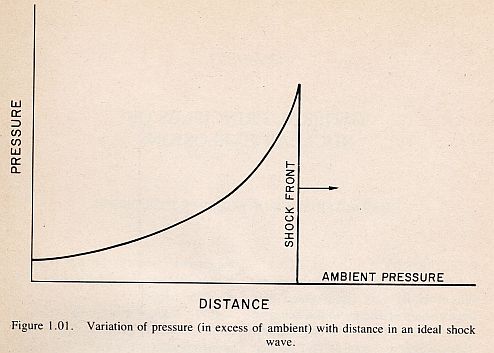1.01
An explosion, in general, results from the very rapid release of a large
amount of energy within a limited space. This is true for a conventional
"high explosive," such as TNT, as well as for a nuclear (or
atomic) explosion, [1]
although the energy is produced in quite different ways (§ 1.11).
The sudden liberation of energy causes a considerable increase of temperature
and pressure , so that all materials present are converted into hot,
compressed gases. Since these gases are at very high temperatures and
pressures, they expand rapidly and thus initiate a pressure wave , called
a "shock wave," in the surrounding medium - air, water or
earth. The characteristic of a shock wave is that there is (ideally)
a sudden increase of pressure at the front, with a gradual decrease
behind it as shown in figure 1.01. A shock wave in
air is generally referred to as a "blast wave" because it
resembles and is accompanied by a very strong wind. In water or in the
ground , however, the term "shock" is used, because the effect
is like that of a sudden impact.
 |
1.02 Nuclear weapons are similar to those of more conventional types insofar as their destructive action is due mainly to blast or shock. On the other hand, there are several basic differences between nuclear and high-explosive weapons. In the first place, nuclear explosions can be may thousands (or millions) of times more powerful than the largest conventional detonations. Second, for the release of a given amount of energy, the mass of a nuclear explosive would be much less than that of a conventional explosive. Consequently, in the former case, there is a much smaller amount of material available in the weapon itself that is converted into the hot, compressed gases mentioned above. This results in somewhat different mechanisms for the initiation of the blast wave. Third, the temperatures reached in a nuclear explosion are very much higher that in a conventional explosion, and a fairly large proportion of the energy in a nuclear explosion is emitted in the form of light and heat, generally referred to as "thermal radiation". This is capable of causing skin burns and of starting fires at considerable distances. Fourth, the nuclear explosion is accompanied by highly penetrating and harmful invisible rays, called "the initial nuclear radiation". |
NOTE:
All the paragraphs with a red heading (example: 1.01)
are reproduced from the Department of the Army Pamphlet "THE EFFECTS
OF NUCLEAR WEAPONS" - NO. 50-3 - Headquarters, Department of the
Army - March 1977 - U.S. Government Printing office : 1983 0 - 406-916.
The publication is not copyrighted.
[1] - The terms "nuclear" and "atomic"
may be used interchangeably so far as weapons, explosions, and energy
are concerned, but "nuclear" is preferred for the reasons given
in § 1.11.